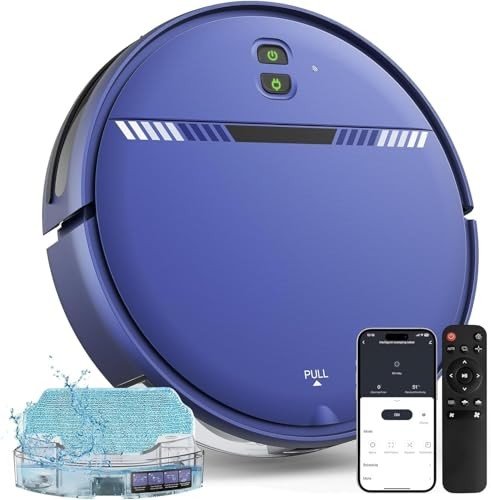The Evolution of Robot Hoovers: Revolutionizing Home Cleaning
Robot hoovers, also known as robotic vacuum, have actually changed how individuals approach home cleaning jobs. Initially presented in the late 1990s, these self-governing makers have evolved rapidly due to improvements in innovation, expert system, and artificial intelligence. Today, they are equipped with a selection of features that make them highly reliable in preserving cleanliness in living areas. This short article explores the history, working, advantages, and future of robot hoovers.
The History of Robot Hoovers
The principle of robotic vacuums dates back to the 1970s, however it wasn't till the launch of the Roomba by iRobot in 2002 that they gained mainstream attention. The Roomba was created to immediately browse various surface areas, avoiding challenges while efficiently cleaning floorings. Since then, numerous significant developments have actually taken place, consisting of:
| Year | Development |
|---|---|
| 1996 | First prototype robotic vacuum cleaner established by a Japanese business. |
| 2002 | iRobot introduces the Roomba, mass promoting robotic vacuums. |
| 2004 | Intro of the very first Roomba with a dirt detection sensing unit. |
| 2011 | Introduce of designs with cordless capabilities and smartphone combination. |
| 2020 | Advanced models featuring AI, improved navigation systems, and mopping abilities. |
How Robot Hoovers Work
Robot hoovers run on a mix of sensors, electronic cameras, and algorithms that allow them to tidy efficiently. Secret parts of these devices include:
Sensors:
- Obstacle Avoidance Sensors: Detect walls, furniture, and even stairs, avoiding crashes and falls.
- Dirt Detection Sensors: Identify areas that require more comprehensive cleaning.
Navigation:
- Gyroscopes: Help figure out the robot's orientation and movement.
- Video cameras and Lidar: Enable mapping of the home environment to develop ideal cleaning paths.
Cleaning Mechanisms:
- Vacuum Motors: Generate suction to get dirt and particles.
- Brush Rollers: Agitate dirt out of carpets for much deeper cleaning.
Power Supply:
- Batteries: Rechargeable lithium-ion batteries provide the necessary power for extended cleaning cycles.
Interface:
- Mobile Apps and Smart Home Integration: Users can arrange cleanings, display efficiency, and manage the robot remotely.
Advantages of Robot Hoovers
Robot hoovers offer various advantages, making them an enticing choice for contemporary families:
- Time-Saving: Automated cleaning allows users to focus on other jobs while the robot effectively cleans floorings.
- Convenience: Many designs can be arranged for cleaning sessions, making sure that homes stay tidy without manual effort.
- Availability: Ideal for individuals with movement obstacles or busy lifestyles, making it possible for simpler home upkeep.
- Constant Cleaning: Regular, automated cleansings reduce the build-up of dirt and allergens, adding to a healthier living environment.
- Smart Technology: Integration with smart home systems permits increased control and customization.
Limitations of Robot Hoovers
In spite of their benefits, robot hoovers feature particular restrictions:
- Navigation Challenges: They may struggle in chaotic areas or with certain floor types such as high-pile carpets.
- Battery Life: Most models require regular charging, which can restrict cleaning period.
- Upkeep: Regular cleaning of filters, brushes, and emptying dust bins is essential for optimal efficiency.
- Price: Advanced models can be pricey compared to conventional vacuum cleaners.
The Future of Robot Hoovers
As innovation continues to progress, the future of robot hoovers looks appealing. Expected improvements consist of:
- Improved AI: Enhanced algorithms will enable much better object recognition and dynamic mapping of spaces.
- Hybrid Models: Integration of vacuuming and mopping capabilities in one device will offer a detailed cleaning option.
- Increased Autonomy: Future designs might browse even the most complex environments without human intervention.
- Sustainability: Battery innovation advancements will lead to longer-lasting, more energy-efficient robots.
Frequently Asked Questions (FAQs)
1. Are robot hoovers effective for animal hair removal?
Yes, many robot hoovers are particularly developed to take on pet hair with effective suction and specialized brushes that minimize tangling.
2. How do robot hoovers browse around furnishings?
Robot hoovers use a combination of sensing units and video cameras to discover obstacles, enabling them to browse around furnishings and avoid collisions.
3. Full Review hoovers clean carpets?
A lot of contemporary robot hoovers are effective on both tough floors and carpets. It is recommended to examine the specifications of individual models for particular performance.
4. Do robot hoovers require shows?
Lots of robot hoovers include easy to use apps that allow owners to set schedules and customize cleaning choices, making programs straightforward.
5. How much do robot hoovers cost?
Rates for robot hoovers differ widely, ranging from ₤ 200 to around ₤ 1,500, depending upon functions and brand.
Robot hoovers have actually come a long way because their creation, using an efficient and practical cleaning service for modern households. Their increasing ability and intelligence make them a practical choice for people seeking to simplify their cleaning routines. As technology continues to advance, robot hoovers will likely become much more capable, supplying extra features that accommodate the developing requirements of users. Their journey from novelty to need highlights a basic shift in how society approaches home maintenance, marking a considerable milestone in the crossway of technology and day-to-day life.

